- Joined
- Apr 30, 2005
- Messages
- 34,293
There is a perceptual problem: These terms are broad, yet people use them to imply something negative when they may not be negative at all... Saying “Beware of painted diamonds” is like saying “Beware of color” or “Beware of inclusions.” There are different degrees of painting, just as there are different levels of color and clarity. It’s not appropriate to stereotype the term.Date: 5/23/2006 11:38:00 AM
Author: Carlotta
The GIA article states that some painting/digging is actually a form of 'cheating' - retaining weight...
Also, maybe the problem is that it is difficult or even impossible for the consumer to be able to tell when a certain line is crossed and it is then 'too much.'
gia allows steep/deep stones, which is a form of retaining weight, in their new system and even calls them 'excellent'Date: 5/23/2006 11:38:00 AM
Author: Carlotta
The GIA article states that some painting/digging is actually a form of 'cheating' - retaining weight...
Also, maybe the problem is that it is difficult or even impossible for the consumer to be able to tell when a certain line is crossed and it is then 'too much.'



Greetings all,
That is an excellent summary John. I''d like to share a slightly different perspective which I''ve made and have been hearing over the course of time we''ve been showing these types of comparisons plus some new insights I''ve been learning with the ASET regarding painted girdle diamonds, particularly in the arena of precision cut H&A type goods.
Date: 5/23/2006 11:30:57 AM
Author:kenny
For hundreds of years diamond cutting has evolved.
Painting and digging seem like just one more improvement in diamond cutting.
What do many in the industry (like GIA) have against it?
GIA actually doesn''t have anything against it. It was the observers in their study that dissed painted girdle diamonds as not being "as bright, firey or scintillating". After the observations were recorded (over 70k of them) GIA basically lumped all the diamonds into the 5 respective categories of their current system (Ex, VG, G, F and P). Of course decisions had to be made where the line was drawn regarding painting/digging and I know the folks who were involved in making these determinations. From the examples we have been able to physically see we have noted (as well as consumers in our store) these optical differences from the Ex to the VG grade. I have an upcoming video program specifically on this subject where I have recorded the differences in a couple of different lighting environments in both painted and dug out diamonds amongst stones that are cut to the highest levels of precision with the only differences being that of painting and digging and how it impacts the face up appearance.
GIA does not ding minor amounts of painting and digging especially when it does not impact face up appearance.
Over the course of the past 6 years, particularly on the Internet and diamonds forums, reflectors like the FireScope, the IdealScope plus our own invention have gained strong popularity and the general thinking on these is "more red and black ... less leakage ... the better the diamond".
The thing is this couldn''t be further from the truth in many instances. Let me expound ...
We are all taught that reds and blacks in an IS image shows us that facets are functioning as "reflectors" and this is indeed true. Red and black in ... should be red and black out. If we can see through the stone to the white behind it those represent facets functioning as *non reflectors*.
However we have discovered through observation testing that a diamond does not draw bright reflections as a result of 3 phenomena ...
The problem primarily lies in what people have been taught about reflectors, particularly red reflectors. Most folks are just not aware of the limitations to these devices. For example, in the minds of many folks *the elimination of all light leakage* is perceived to be a performance enhancing feature when in fact when we observe the same diamond through an ASET, the ASET suggests differently.

Thus far I have found what the ASET teaches (in most circumstances), the DiamondDock demonstrates. This isn''t the first time we''ve drawn corellations with competing companies teaching about the same subject. In the past we demonstrated quite plainly the corellations between red reflectors and BrillianceScope results even though they are 2 competing technologies.
Below are graphics demonstrating what I''m talking about. The diamond on the right is a painted stone with superior craftsmanship alongside a non painted stone with equally precise craftsmanship. If one were strictly looking at the red reflector images one could conclude that the elimination of all leakage = performance enhancing. However once you view the ASET''s of the same identical stones you can easily see that the painted girdle diamond is drawing more light from the horizon is indicated by the presence of more greens in the upper half region.
The ASET shows it in a critical exam... the DiamondDock demonstrates it in a practical exam (as well as other common lighting environments depicting brightness).
It begs the question ... how much light can be drawn from the horizon before it starts negatively impacting face up appearance?
Answer: Let the consumer decide, if indeed they want to consider painted girdle diamonds in their selection criteria.
So far from what I have read and physically seen regarding GIA''s outlines for what they ding and don''t ding I like what they have laid out. Stones that get dinged do differ in appearance that we are able to note. This has been our experience so far. I have also seen painted stones wherein the painting was slight ... these stones would not get dinged which agrees with the chart that GIA published on the subject not long ago.
What we must be careful to differentiate is the difference between craftsmanship (resulting in precision cutting) vs light performance that can be assessed with the human eyes (observation testing/direct assessment) because the 2 should not be confused and rightfully so because you can have have a sloppily cut diamond be brighter in appearance than a precision cut diamond.
In closing ...
If you are an individual who has a preference towards stones with painted girdles and you''ve seen and compared them and prefer them ... then you should buy them. I have and would sell them if indeed that is what a person wants and prefers and we do stock a few. I am for individual''s getting what pleases their eyes most. Personally ... they are not my favorites and these aren''t the only type of stones we sell that don''t make Ex grade. My inventory has reflected my conviction about this over the course of years and is no secret. This is why GIA''s studies come as no surprise here, at least to me. I understand that folks do not understand GIA''s system, especially if they do have a preference towards these stones, however just because people have a preference towards a particular cutting style does not mean GIA is wrong. There is a certain segment of people who prefer shallow angled diamonds which take hits in both GIA and AGS systems. These folks may not comprehend why such stones take dings in both their systems and may criticize them for it, however it does not make GIA and AGS wrong because of this segments personal preference. Same could be said for older cuts which wouldn''t make Ex grade.
The system is here, it''s in place ... yes changes may be made over time to fine tune it but instead of throwing rocks at things we may not fully understand just yet my advice is to study it, learn it, teach it and educate consumers about it. I understand that major Japanese laboratories (including AGL, Zenhokyo, etc.)have also adopted the new GIA cut grading system into their own so their research gemologist''s must also see validity to the logic & science behind it as well.
Anyhow ... this is my perspective after purchasing the materials used for determing the new grades (both GIA and AGS) and studying to death all the material I have had the time to on these subjects as well as talking personally with the research gemologists in both laboratories and viewing a good variety of subject diamonds.
So Kenny... my quick and short answer to your threads question "Why would anyone object to painting?" is...
"Because it contributes to a decrease in optical characteristics once certain thresholds are met in both painting and digging which can be explained and seen in technologies released by both major laboratories and agree with human observation testing conducted on both small scale (by lil guys like me) and on a much grander scale such as GIA has done."
To some the differences aren''t that drastic and in some lighting environemtns its tough to see too, but to others its enough to cause them to decide against it. Each person is different and brings different elements to the observational playing field (body size, focal length, lighting in which the exam is done in etc.) which may cause them to choose one way or the other.
Hope this helps.
Peace,
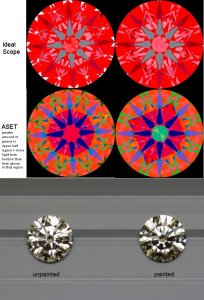
Why would added horizon light cause a diamond to appear darker? What is the math behind this? Not trying to challenge, just trying to understand.If you have 2 super ideal cut diamonds and one is drawing more light from the horizon than the other which is drawing more light from above, the diamond drawing more light from the horizon will take on additional darkness resulting in less brightness.
I don''t see why... Could you please explain?It doesn''t take a rocket scientist to see that painted girdle diamonds do indeed draw more light from the horizon than from above
The horizon light is the light from 0 to 45 degrees, it is normally ambient light or reflected light and is less intense than the overhead light that we get from 45-75 degrees, such as sunlight or overhead lighting. The blue, contrast, is from the head shadow at 75-90 degrees.Date: 5/23/2006 5:49:15 PM
Author: Excoriator
Why would added horizon light cause a diamond to appear darker? What is the math behind this? Not trying to challenge, just trying to understand.If you have 2 super ideal cut diamonds and one is drawing more light from the horizon than the other which is drawing more light from above, the diamond drawing more light from the horizon will take on additional darkness resulting in less brightness.
Also,
I don''t see why... Could you please explain?It doesn''t take a rocket scientist to see that painted girdle diamonds do indeed draw more light from the horizon than from above


Date: 5/23/2006 7:07:55 PM
Author: Mara
i didn''t even read the whole latest chapter, rhino, but i will say that when you posted those images, my absolute first thought was wow the one on the right looks way better than the left. and voila, that is the painted stone. guess it''s a good thing i own three of them since i obviously tend to prefer that just from the images.
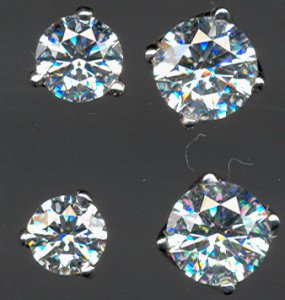
hahahhaha...i was thinkng that too!Date: 5/23/2006 7:32:40 PM
Author: dhog
Date: 5/23/2006 7:07:55 PM
Author: Mara
i didn''t even read the whole latest chapter, rhino, but i will say that when you posted those images, my absolute first thought was wow the one on the right looks way better than the left. and voila, that is the painted stone. guess it''s a good thing i own three of them since i obviously tend to prefer that just from the images.
I agree on the stone on the right as I have five of
these painted stones. Maybe the dark spots are full of colored
light that the eye is not able to detect or a camera lens can
capture at long ranges. Out west here in wine country we prefer
fire during wine tasting events. I did a quick airbrush job on these
4 stones and then did a close up with ultra high intensity cathode ray tubes to get these effects in broad daylight with no background
to effect the outcome of these stones.

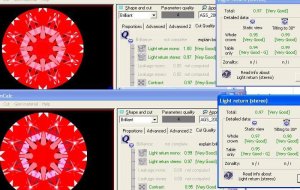
it''s been awhile since you''ve seen 8* or the painted ags0''s, or both?Date: 5/23/2006 8:10:30 PM
Author: strmrdr
its been a while but iv seen 8* and ags0 diamonds with great angles, painted girdles and nice h&a in person.
Date: 5/23/2006 8:18:01 PM
Author: belle
it''s been awhile since you''ve seen 8* or the painted ags0''s, or both?Date: 5/23/2006 8:10:30 PM
Author: strmrdr
its been a while but iv seen 8* and ags0 diamonds with great angles, painted girdles and nice h&a in person.
that is what i was thinking...well cut diamonds aren''t very common locally to many people. how did you know the diamonds were painted?Date: 5/23/2006 8:27:13 PM
Author: strmrdr
Date: 5/23/2006 8:18:01 PM
Author: belle
it''s been awhile since you''ve seen 8* or the painted ags0''s, or both?Date: 5/23/2006 8:10:30 PM
Author: strmrdr
its been a while but iv seen 8* and ags0 diamonds with great angles, painted girdles and nice h&a in person.
its been a while for both.
They arent very common around here, any kind of well cut diamond is very uncommon localy to me.
We did this too, Wink, precisely because of this late PS 'buzz' about painted diamonds.Date: 5/23/2006 6:58:22 PM
Author: Wink
Rhino, I just can't buy into it. I got out my EightStars and I got out my Infinity diamonds and I looked at them side by side, comparable size to comparable size, and I just can not see this darkness that you talk about.
I put them on the ASET and I agree that the EightStar does in fact draw more green than the Infinity, but I can not see any darkness. I tried it with my spots on, and with my spots off in fluorescent lighting like a typical office. Two gorgeous diamonds, without doubt. One painted, one not, but not a bit of darkness around the edges could I find.
I showed them to four random people, two could not make a decision which was better than the other and one like the painted stone, one the none painted stone, neither could say exactly why. Gotta confess, it is pretty hard to tell them apart and I am good at it. I am afraid I am just going to have to dissagree with you, and GIA, on this. I think they are wrong. The rest of the world may think they are right, but heck, just call me stubborn, I think they are wrong.
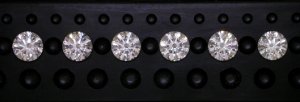
That''s cool Mara. When we show clients comparison''s, whether its this or H&A vs Eighternity, Eighternity vs Solasfera, etc. etc. etc. our suggestion on what they should purchase is always to select what pleases their eyes most. When showing clients via pictures ... pictures are good but now I kinda like video as you get to see it rocking and in multiple tilt positions but one of the weakness of photo and video is it''s monocular and not stereo. It does give a very good idea though.Date: 5/23/2006 7:07:55 PM
Author: Mara
i didn''t even read the whole latest chapter, rhino, but i will say that when you posted those images, my absolute first thought was wow the one on the right looks way better than the left. and voila, that is the painted stone. guess it''s a good thing i own three of them since i obviously tend to prefer that just from the images.


Questions are good. Even challenges are good.Date: 5/23/2006 5:49:15 PM
Author: Excoriator
Why would added horizon light cause a diamond to appear darker? What is the math behind this? Not trying to challenge, just trying to understand.If you have 2 super ideal cut diamonds and one is drawing more light from the horizon than the other which is drawing more light from above, the diamond drawing more light from the horizon will take on additional darkness resulting in less brightness.

Sure. If you look at the 2 ASET images I posted, the diamond on the right (the painted girdle diamond) displays a greater saturation of green around the perimeter (or upper girdle region). If you look carefully at the photograph of the 2 diamonds below the ASET images you will note a greater amount of darkness precisely where that green exists in the ASET. A pretty fascinating corellation between the 2 labs technologies I think. Hope that helps.Also,
I don't see why... Could you please explain?It doesn't take a rocket scientist to see that painted girdle diamonds do indeed draw more light from the horizon than from above
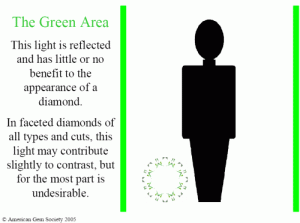
Thanks for the info Mara....I honestly can say I have missed the boat on this topic.Date: 5/23/2006 10:07:38 PM
Author: Mara
heather, girl, where have you been?? this is just one of the nine hundred million threads on painted girdles...hehe.
but the jist is that you can tell if a stone is painted if the light return on the IS is all black and red with no white light leakage on the edges; but if it has leakage along the edges it''s typically not painted. WF''s ACA line is some painted and some classic (not painted) as are Eightstars.

Wink you should know better than to look at diamonds in normal lighting.Date: 5/23/2006 6:58:22 PM
Author: Wink
Rhino, I just can''t buy into it. I got out my EightStars and I got out my Infinity diamonds and I looked at them side by side, comparable size to comparable size, and I just can not see this darkness that you talk about.
I put them on the ASET and I agree that the EightStar does in fact draw more green than the Infinity, but I can not see any darkness. I tried it with my spots on, and with my spots off in fluorescent lighting like a typical office. Two gorgeous diamonds, without doubt. One painted, one not, but not a bit of darkness around the edges could I find.
I showed them to four random people, two could not make a decision which was better than the other and one like the painted stone, one the none painted stone, neither could say exactly why. Gotta confess, it is pretty hard to tell them apart and I am good at it. I am afraid I am just going to have to dissagree with you, and GIA, on this. I think they are wrong. The rest of the world may think they are right, but heck, just call me stubborn, I think they are wrong.
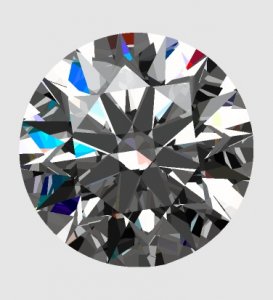
hlmr, you haven''t missed a boat - you''re seeing a few sailors arguing about knots. Go into several jewelry stores in your area and ask about painting. I wager not many salespeople will even know what you are talking about, much less the variables we are slicing and dicing here.Date: 5/23/2006 10:50:26 PM
Author: hlmr
Thanks for the info Mara....I honestly can say I have missed the boat on this topic.
Must go and educate myself.
